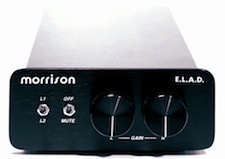It’s the time of year for saving money!
 About a month ago I bought a Morrison E.L.A.D. preamp off Ebay. I’ve known Don Morrison for more than 30 years. I talked with him via phone when I was researching Stew Hegeman for a series of articles in The Absolute Sound. I was more familiar with his speakers, which are based on a Hegeman design, than his preamp. But when I saw an E.L.A.D. come up for auction I couldn’t resist snapping it up.
About a month ago I bought a Morrison E.L.A.D. preamp off Ebay. I’ve known Don Morrison for more than 30 years. I talked with him via phone when I was researching Stew Hegeman for a series of articles in The Absolute Sound. I was more familiar with his speakers, which are based on a Hegeman design, than his preamp. But when I saw an E.L.A.D. come up for auction I couldn’t resist snapping it up.
A good part of my enthusiasm came after reading Peter Aczel’s review on Don Morrison’s website. Aczel heaped on praise, saying the E.L.A.D. was “utterly transparent” and “as close to ‘a straight wire with gain’ as we are likely to get.” To an audiophile, that’s the equivalent of waving a big red sheet in front of a bull. I really wanted to hear the E.L.A.D. for myself.
When the preamp arrived I was impressed by not only its internal layout, which was as neat and well-executed as any preamp I’ve seen regardless of price, but also it’s ergonomics. The front controls consist of a mute on/off switch, a two-input toggle, and a pair of volume controls. That’s it. And, that’s really all you need. To turn on the preamp you merely plug it’s power supply into the wall and attach the connector cable between the power supply and the preamp, wait a couple of minutes for the circuit to stabilize, (if you don’t wait you may hear some faint low level noise while the servo circuit sets) and you’re ready to do some serious listening. Even when the E.L.A.D on continuously the preamp and power supply barely get warm.
So how good is the E.L.A.D? While I wouldn’t lay on quite as many superlatives as Mr. Aczel, the E.L.A.D. certainly rivals any active preamp I’ve auditioned on my desktop system. I don’t feel it is quite as transparent as my Reference Line passive preamp, but the Morrison E.L.A.D makes up for that with it’s greater dynamic contrast and additional bass response. The E.L.A.D is also exceptionally quiet and adds virtually no electronic grain or texture to the music. I was also surprised and impressed by its imaging specificity, which rivaled the Reference Line preamp.
Taken as a whole the $1299 (current price) Morrison E.L.A.D preamp ranks as an exceptional value that is perfectly suited for desktop preamp duties. Is it a virtual straight wire with gain? Not quite, but it is a super performer at a price that even an audiophile on a tight budget can afford.
Don Morrison, I owe you a beer…






Most “audiophiles” carry the baggage of the past with them. Best audiophile tweak, is to use a bulb of hot water, to melt your old ear wax, then do frequency response on your room, and make physical corrections or digital equalization. Audiophilia is dead, face it, it died with computer audio. I’m glad, because the music is whats important. Despite the fact that I have $30,000 plus gear, I listen to most on an X-Fi outboard card with AKG reference headphones. It’s close to as good as you can get, and under $400 to put together. The use of negative feedback, and modern opamp design, are nothing like the 70’s. Computers have changed everything. Now opamps can be designed by TI/NSM to avoid issues of the past. But audiophiles can’t let it go, even if the thing has .0001% distortion, and vast noise floor, they still dabble in pseudoscience. 2nd and 3rd order harmonics which sum into the hearing range are what I try to reduce in my own systems. But you need to be an professional EE to understand the concepts, so it’s easier to say “this sounds better”. It’s much easier to pretend you can hear differences when there are none. Placebo effect. Peter Aczel has no patience for fools. The ELAD is an awesome preamp, but my only quibble with it is matching volume levels left and right by eye, I find that difficult.
I’m glad you enjoy the preamp, but really there are some terrific and highly acclaimed preamps for much less than that. I’ve always believed if you don’t $100,000 speakers to support the electronics, well you’ve probably over paid.
And they would be? I’m not a big fan of the “I’ve got a list” gambit without some specifics. BTW Your last sentence isn’t one.